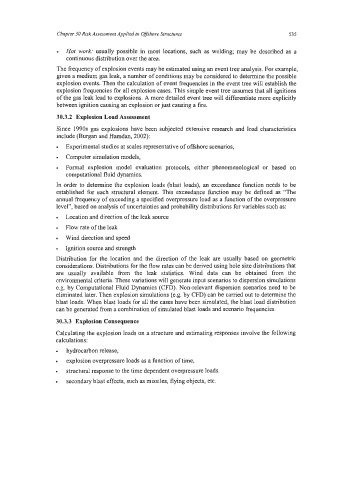Page 559 - Marine Structural Design
P. 559
Chapter 30 Risk Assessment Applied to Offshore Structures 535
Hot work: usually possible in most locations, such as welding; may be described as a
continuous distribution over the area.
The frequency of explosion events may be estimated using an event tree analysis. For example,
given a medium gas leak, a number of conditions may be considered to determine the possible
explosion events. Then the calculation of event frequencies in the event tree will establish the
explosion frequencies for all explosion cases. This simple event tree assumes that all ignitions
of the gas leak lead to explosions. A more detailed event tree will differentiate more explicitly
between ignition causing an explosion or just causing a fire.
30.3.2 Explosion Load Assessment
Since 1990s gas explosions have been subjected extensive research and load characteristics
include (Burgan and Hamdan, 2002):
Experimental studies at scales representative of offshore scenarios,
Computer simulation models,
Formal explosion model evaluation protocols, either phenomenological or based on
computational fluid dynamics.
In order to determine the explosion loads (blast loads), an exceedance fknction needs to be
established for each structural element. This exceedance function may be defined as “The
annual frequency of exceeding a specified overpressure load as a function of the overpressure
level”, based on analysis of uncertainties and probability distributions for variables such as:
Location and direction of the leak source
Flow rate of the leak
Wind direction and speed
Ignition source and strength
Distribution for the location and the direction of the leak are usually based on geometric
considerations. Distributions for the flow rates can be derived using hole size distributions that
are usually available from the leak statistics. Wind data can be obtained from the
environmental criteria. These variations will generate input scenarios to dispersion simulations
e.g. by Computational Fluid Dynamics (CFD). Non-relevant dispersion scenarios need to be
eliminated later. Then explosion simulations (e.g. by CFD) can be camed out to determine the
blast loads. When blast loads for all the cases have been simulated, the blast load distribution
can be generated from a combination of simulated blast loads and scenario frequencies.
30.3.3 Explosion Consequence
Calculating the explosion loads on a structure and estimating responses involve the following
calculations:
hydrocarbon release,
explosion overpressure loads as a hnction of time,
structural response to the time dependent overpressure loads.
secondary blast effects, such as missiles, flying objects, etc.

